
Journey with Raven • The North Rim of the Grand Canyon

Secrets from the North Rim
We had gone to the south rim of the Grand Canyon last year, and our assessment was that it was the most touristy, and consequently our least favorite part of the trip. It was the most congested of all the parks we had gone to, with hundreds of people crowding the rails, and busses belching black diesel smoke into the otherwise fresh air. And that was the off season, in dead of winter! This time around, we decided we'd try the north rim, which all the literature said was much less visited.
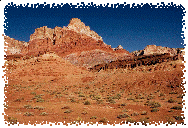 |
| The Vermilion Cliffs, on the Road to the North Rim |
Thankfully, they were right. It's 204 miles from the south rim to the north rim by road (though only 10 miles as Raven flies.) Even from Page – ostensibly very near to the north rim – the road is at best circuitous. But it is beautiful, especially as you drive along the base of the Vermilion cliffs.
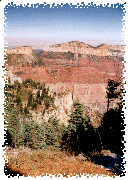 |
| Looking East from Point Imperial |
In the park, things were low-key. This is in large part because the north rim, a thousand feet higher than the south rim, closes during the winter, and we just happened to arrive on the last day. But the folks that come here took the effort, and are a hardier sort that look for the austere ruggedness this part of the park offers. No nail salons and beauty parlors in the lodge here.
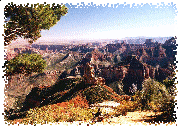 |
| Hayden Point as seen from Point Imperial |
And though the vistas are fewer in number, the views they offer are splendid. Point Imperial affords a commanding view of the north-east end of the canyon. Looking from a vantage higher than the south rim, you get a greater sense of depth.
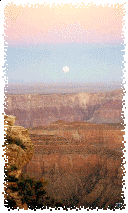 |
| The Full Moon Rising over the Grand Canyon as seen from Cape Royal |
Much farther down a twisty road, you come to Cape Royal, a promontory from which you are able to see the entire eastern part of the park. We arrived shortly before sun-down, and shadows had already darkened the canyon floor. Atmospheric haze muted the visibility westward, but as the sun set into a glorious rosy west, the full moon ascended from the east, rising through vivid bands of cyan, lavender, and pink.
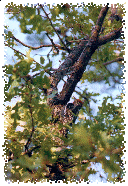 |
| A Woodpecker Busies Himself with a Snack |
The following morning we emerged from our rustic cabin to an even less populous park. The already Spartan services had shut their doors for the winter, and now only the stragglers -- and the true residents of the park -- remained.
A woodpecker busied himself with breakfast just outside our window, while a family of deer watched us carry our luggage back to the car. They were neither afraid nor disturbed by our presence, and merely monitored our progress, as if expressing their impatience with our departure.
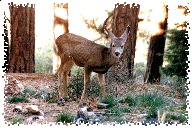 |
| Deer Graze Just Outside the Cabins |
Though the services were closed for the winter, the park was still technically open (and would remain so until the first snow forced the closure of the roads.) Consequently, a handful of determined visitors still lingered around the rim of Bright Angel Point. Many had large backpacks and no doubt intended to make the crossing to the south rim. Even though the north rim could be shrouded in snow soon, the canyon floor, a mile beneath us, is essentially a desert, so there was no urgency in making the crossing.
 |
| Looking Southward from Bright Angel Point. The other rim is ten miles away |
Without a doubt, the relative remoteness and more rustic atmosphere made the north rim far more enjoyable than the south rim. Though if I were compelled to find fault, my sole lament would be that being southward-looking, photography proved more difficult. The sun would seldom be at the ideal position, to one side or the other. Some complaint, I know.
Stacked against the other places we visited, I think the Grand Canyon would be high, though not the very top of my list. It's greatest attribute, its size, in some ways is almost incomprehensible. It is at a scale completely beyond most peoples' ken, whereas in Bryce Canyon the hoodoos are still on the same order of magnitude as trees, and the amphitheater is not any larger than any other natural feature throughout the world. None the less, it is a remarkable place, singular in its own beauty, and well worth visiting again.
Tell a Friend about this page!
unless otherwise indicated
All Rights Reserved
Reproduction or distribution without prior written permission is strictly prohibited.
Scripting and DHTML by Technomancer Software
technomancer.ws
Privacy Policy